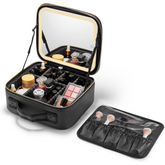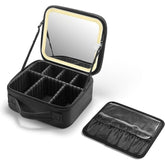Understanding LED Lights and Their Three Light Modes: Warm, Cold, and Natural
LED lights have become a popular choice for homes, offices, and even for makeup mirrors due to their energy efficiency, long lifespan, and versatility. One of the great features of LED lighting is the ability to switch between different light modes: warm, cold, and natural. Each of these modes serves different purposes and can significantly impact the ambiance of a room. Let's explore these light modes and understand their unique benefits.
What Are LED Lights?
LED stands for Light Emitting Diode. Unlike traditional incandescent bulbs that use a filament, LEDs produce light through a process called electroluminescence. This makes them more energy-efficient and longer-lasting. LEDs are available in various shapes, sizes, and colors, making them suitable for a wide range of applications.
The Three Light Modes
1. Warm Light
Warm light has a yellowish hue, similar to the light emitted by traditional incandescent bulbs. It usually ranges from 2700K to 3000K on the Kelvin scale.
Benefits of Warm Light:
Creates a Cozy Atmosphere: Warm light is ideal for living rooms, bedrooms, and dining areas as it creates a cozy and inviting environment.
Reduces Eye Strain: The softer glow of warm light is easy on the eyes, making it perfect for relaxation and winding down after a long day.
Enhances Warm Colors: It accentuates warm colors like reds, oranges, and yellows, making them appear richer and more vibrant.
2. Cold Light
Cold light, also known as cool or daylight light, has a bluish tone and typically ranges from 5000K to 6500K on the Kelvin scale.
Benefits of Cold Light:
Boosts Productivity: Cold light is often used in workspaces and offices because it mimics natural daylight, which can help increase alertness and productivity.
Enhances Concentration: The bright, crisp light helps improve concentration and focus, making it ideal for tasks that require attention to detail, such as reading or working on a computer.
Accentuates Cool Colors: It highlights cool colors like blues and greens, giving spaces a clean and modern look.
3. Natural Light
Natural light falls somewhere between warm and cold light, typically ranging from 3500K to 4500K on the Kelvin scale. It closely resembles the natural light from the sun.
Benefits of Natural Light:
Versatile and Balanced: Natural light is versatile and suitable for various activities, making it a good choice for general lighting in any room.
True Color Representation: It provides a balanced light that helps in accurate color representation, which is particularly beneficial for tasks like cooking, grooming, and art projects.
Mood Enhancing: Natural light can enhance your mood and overall well-being, making spaces feel more comfortable and inviting.
Choosing the Right Light Mode
Selecting the right light mode depends on the purpose of the room and the desired ambiance. Here are a few tips to help you choose:
Living Rooms and Bedrooms: Use warm light to create a cozy and relaxing environment.
Kitchens and Bathrooms: Opt for natural light to ensure true color representation and a balanced ambiance.
Home Offices and Study Areas: Choose cold light to boost productivity and maintain focus.
LED lights with adjustable modes offer great flexibility to tailor the lighting to your specific needs and preferences. By understanding the differences between warm, cold, and natural light, you can create the perfect atmosphere in any room. Whether you need a cozy, relaxing space or a bright, productive environment, LED lights have got you covered.



